Stem Cells: 2006 Update
- Posted 01.10.06
- NOVA scienceNOW
(This video is no longer available for streaming.) In this story from January 2006, NOVA scienceNOW reports on stunning developments in the field of stem cell research. The South Korean scientist heralded a year earlier for his innovative research is found guilty of fabricating his results, including reportedly groundbreaking work cloning human embryonic stem cells. The Korean fiasco casts a cloud over the field, but U.S. researchers still move forward, believing that embryonic stem cells hold great potential for medicine. As part of this advancement, a team led by Rudolf Jaenisch at MIT explores a way to produce embryonic stem cells without using an embryo that can develop into a fetus.
Transcript
STEM CELLS UPDATE
PBS Airdate: January 10, 2006
ROBERT KRULWICH: One of the most controversial science stories of the year involves stem cells, cells that may one day cure terrible diseases. But the problem with stem cells is they often come from embryos, thus the phrase "embryonic stem cells." And embryos, while they start no bigger than a grain of sand, can become babies, so there is a moral issue here.
But what if—and we're just going to think out loud—what if you could make an embryonic stem cell without creating an embryo? Could you? Should you? Well, we know someone who's trying. Reporter Julia Cort has the story.
JULIA CORT (Correspondent): As he winds through the labs of M.I.T., Alex Meissner is trying to sidestep an ethical minefield. He hopes the tiny cells that float in his Petri dish might hold the key to solving one of the biggest controversies facing science: whether it's ethical to use cells from human embryos in medical research.
RUDOLF JAENISCH: I believe this research has enormous potential. And it will revolutionize medicine in the years to come.
THOMAS BERG: I don't want to live in a world, I don't think anyone wants to live in a world, where we're destroying embryos...we're creating them and destroying them in mass quantities for research purposes.
JULIA CORT: While experts debated here, halfway around the world, South Korea seemed to be forging ahead. Last August, they claimed a spectacular first, a cloned dog.
But since then, the Korean king of clones, Hwang Woo-Suk, has been dethroned, accused of fabricating his results, including groundbreaking work cloning human embryonic stem cells. The Korean fiasco has cast a cloud over the field, but U.S. researchers still want to move forward, believing embryonic stem cells hold great potential for medicine, since they can become any kind of cell in the human body. But because they come from early human embryos, funding for the research is extremely limited.
GEORGE DALEY (Harvard Stem Cell Institute): Unfortunately, here in the United States, even though we're chomping at the bit to do the work, the kind of funding restrictions that we're under, the kind of presidential policy that we're under, is really the hindrance.
JULIA CORT: Physician and researcher George Daley is eager to create stem cells that are an exact match to sick patients. To do that, he wants to try cloning technology, but so far, the only cloned cells he's made belong to mice.
GEORGE DALEY: We're essentially frozen in time, at 2001, while the rest of the world has moved forward very, very aggressively.
JULIA CORT: The controversial cloning process would work like this: take an egg from a woman's ovary, remove its genes or DNA, then, get a cell—like a skin cell—from a patient, and put its DNA into the egg. The egg is stimulated to divide, as if it had been fertilized. After a few days, the early embryo has 50 to 200 cells.
The goal is to turn some of these into embryonic stem cells that would be a perfect genetic match to a sick patient. But because the cloned embryo would be destroyed in the process, critics say this research is wrong. With the destruction of human embryos at the center of the debate, a few scientists approached the new year asking if it might be possible to make both sides happy. What if they could find a way to create embryonic stem cells without destroying any embryos?
WILLIAM HURLBUT (Stanford University): I think it should be doable.
JULIA CORT: Physician and ethicist William Hurlbut thinks the solution may lie in tinkering with the cloning process.
WILLIAM HURLBUT: There's a way to get the cells without creating embryos. We just have to have the constructive conversation to find the way.
JULIA CORT: The challenge intrigued M.I.T.'s Rudolf Jaenisch, a leading expert on stem cells and cloning. With the help of graduate student Alex Meissner, Jaenisch tried to create something that would yield stem cells, but was not an embryo at all.
RUDOLF JAENISCH: What is an embryo? What's important? I think an important part of the sense of an embryo is the potential to develop, to organize itself.
JULIA CORT: The Jaenisch team set out to eliminate that potential. First, they took a tiny bit of skin from a mouse's tail and let it grow in culture. With the skin cells growing in a Petri dish, Meissner concocted a special virus and added it to the skin cells. The virus went to work and inserted an extra bit of DNA into the skin cell DNA. Meissner performed the cloning, sucking up a skin cell now containing the extra DNA and transferring it into a mouse egg. And then the team waited and watched. Jaenisch's hope was that the extra bit of DNA they'd added would shut down one key gene, a gene that's crucial for organizing the early mouse embryo and triggering the construction of the placenta.
RUDOLF JAENISCH: The placenta, of course, is very important in signaling the fetus to develop. Without the placenta, it cannot. And the experiment worked very straightforward. It was actually surprisingly simple to us.
JULIA CORT: With that key gene turned off, the unorganized cluster of cells did not develop normally, and, Jaenisch says, would never become a baby mouse. But it could be turned into useful stem cells.
RUDOLF JAENISCH: The real question is, does it solve the ethical problem? Some people said yes, others said, "No. It's a particularly devious way to murder an embryo." I would argue, from the biological point of view, it is not an embryo. It doesn't qualify to be called this. It doesn't have any potential whatsoever to ever organize itself to a fetus.
JULIA CORT: Father Thomas Berg is encouraged by Jaenisch's experiment.
THOMAS BERG: I think the jury's still out as to whether it's an embryo or not. But I think it's incredibly interesting, from a moral standpoint, from a scientific standpoint, obviously. I think what Rudy Jaenisch did holds out some hope that those of us who do not want to live with a future of embryo-destructive research, we might have a way out.
JULIA CORT: But so far, there is no consensus about the moral status of what Jaenisch created among stem cell opponents or supporters.
ARTHUR CAPLAN (University of Pennsylvania School of Medicine): The scientists who play along, I think, are playing the wrong card. They think, "Yeah, maybe if I'm clever enough I'll satisfy all the critics." I think the critics are not going to be satisfied. I think they don't want to see embryonic stem cell research happen, and I don't think they want to see anything involving cloning happen.
JULIA CORT: Ethical objections have slowed U.S. research. Few labs have tried to use cloning to make human stem cells, and none have succeeded. The Korean scandal means that the technique for humans is unproven. But that, for many U.S. researchers, is all the more reason to keep moving ahead.
GEORGE DALEY: I have patients, and I can see a way to apply this technology to study their disease and perhaps treat their disease. I want to be able to use that process today.
ARTHUR CAPLAN: If we get diverted into the debate about, "Can we make a pseudo embryo or an embryo-like thing?," you could spend the next five, 10 years trying to figure out how to tweak an egg or play with embryos. I think, to spend too much time trying to respond to every possible critic is a recipe for paralysis, not for breakthroughs.
ROBERT KRULWICH: Around the corner, around the world, more science stories in the news. Hamburg, Germany: toads are exploding at an alarming rate—1,000 believed dead. And why? Maybe they were bitten and infected by crows, but, says German scientist Heidi Meyerhofer, "Nein!"
HEIDI MEYERHOFER (Translation from German): I have been working here for 15 years and have never experienced a problem this big with amphibians. Experts could give no advice about the symptoms.
ROBERT KRULWICH: In short, scientists haven't the froggiest idea.
Meanwhile, back in the U.S.A. —if you drive, put down the cell phone because researchers discovered this past year that a normal 30-year-old driver speaking on a cellular telephone has the reaction time of a 70- or 80-year-old. Oh dear! Phones and driving prove a deadly mixture. And that's no phony baloney.
Credits
Stem Cells: 2006 Update
- Executive Producer
- Samuel Fine
- Executive Editor
- Robert Krulwich
- Senior Series Producer
- Vincent Liota
- Senior Producer
- Robe Imbriano
- Producers
- Julia Cort
Carla Denly
Robe Imbriano
Dean Irwin
Vincent Liota
Mary Robertson
Win Rosenfeld - Editors
- Ben Ehrlich
Nathan Hendrie
Robe Imbriano
Vincent Liota
Win Rosenfeld - Supervising Producer
- Andrea Cross
- Development Producer
- Kyla Dunn
- Program Editor
- Steve Trevisan
- Associate Producers
-
Anthony Manupelli
Mary Robertson
Win Rosenfeld
Ayo Babatunde
Shimona Shahi - Unit Manager
- Candace White
- Production Secretary
- Ayo Babatunde
- Compositing
- Yunsik Noh
- Production Assistant
- Robbie Gemmel
- Music
- Rob Morsberger
- NOVA scienceNOW Series Animation
- Edgeworx
- Camera
- Chris Borghesani
George Delgado
Brian Dowley
Tom Fahey
Vikram Gandhi
Robert Hanna
Michael Hunkley - Sound Recordists
- Paul Austin
Vikram Gandhi
Mike Karas
Dennis McCarthy
Gilles Morin
Alex Sullivan - Audio Mix
- John Jenkins
- Animation
- Mitch Butler
Edgeworx
Picket Design
Pie Design - Special Thanks
- Clifford Cunningham
Foxwoods Resort Casino
The Graduate Center at CUNY
Alex Meissner
Naturally Tasty Health Food
The New York Number Theory Seminar
The officers and crew of the NOAA ships Delaware II and Albatross IV
Jí¡nos Pintz
Salon Mario Russo
Cem Yildirim
Adam Zoghlin - Archival Material
- ABC News Video Source
Art. Lebedev Studio
Mike Brown, Caltech
Michael Brumlik
Jewel Webb Chambers
CNN
CORBIS Motion
Michael DiGiorgio, Worldwide Nature Artists Group
Denis Finnin, American Museum of Natural History
Richard Gibbe
Dennis Kunkel Microscopy, Inc.
Robert Hurt (IPAC)
Jupiterimages Corporation
The Macaulay Library at the Cornell Lab of Ornithology
MODIS Rapid Response Project at NASA/GSF
Museum of Comparative Zoology, Harvard University
NASA/JPL
NASA/JPL-Caltech
Jay Pitocchelli
Prairie Pictures / StormStock, Martin Lisius
24 Images
N. John Schmitt
Ultimate Chase Stock Video
Mitch Waite
WWL-TV - NOVA Series Graphics
- yU + co.
- NOVA Theme Music
- Walter
Werzowa
John Luker
Musikvergnuegen, Inc. - Additional NOVA Theme Music
- Ray Loring
- Post Production Online Editor
- Spencer Gentry
- Closed Captioning
- The Caption Center
- NOVA Administrator
- Dara Bourne
- Publicity
- Eileen Campion
Olivia Wong - Senior Researcher
- Barbara Moran
- Production Coordinator
- Linda Callahan
- Unit Managers
- Lola
Norman-Salako
Carla Raimer - Paralegal
- Richard Parr
- Legal Counsel
- Susan Rosen Shishko
- Post Production Assistant
- Alex Kreuter
- Associate Producer, Post Production
- Patrick Carey
- Post Production Supervisor
- Regina O'Toole
- Post Production Editor
- Rebecca Nieto
- Post Production Manager
- Nathan Gunner
- Supervising Producer
- Stephen Sweigart
- Producer, Special Projects
- Susanne Simpson
- Coordinating Producer
- Laurie Cahalane
- Senior Science Editor
- Evan Hadingham
- Senior Series Producer
- Melanie Wallace
- Managing Director
- Alan Ritsko
- Senior Executive Producer
- Paula S. Apsell
NOVA scienceNOW is a trademark of the WGBH Educational Foundation
This material is based upon work supported by the National Science Foundation under Grant No. 0229297. Any opinions, findings, and conclusions or recommendations expressed in this material are those of the author(s) and do not necessarily reflect the views of the National Science Foundation.
© 2006 WGBH Educational Foundation
All rights reserved
- Image credit: (stem cells growing) Courtesy Daniel Anderson
Participants
- Father Thomas Berg
- Associate Professor of Moral Philosophy, the Center for Higher Studies of the Legion of Christ
- Arthur Caplan
- Director of the Center for Bioethics, University of Pennsylvania
- Julia Cort
- WGBH Science Unit
- George Daley
- Children's Hospital Boston www.childrenshospital.org/cfapps/research/data_admin/Site92/mainpageS92P0.html
- William Hurlbut
- Consulting Professor in the Program in Human Biology, Stanford University
- Rudolf Jaenisch
- Founding Member of the Whitehead Institute
Related Links
-
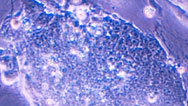
Stem Cells Breakthrough
Three separate teams overcome a biomedical hurdle: creating stem cells without the use of human embryos.
-
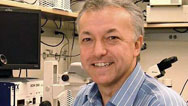
Stem Cells Breakthrough: Q&A
George Daley of Children's Hospital Boston answers questions about stem cell research.
-
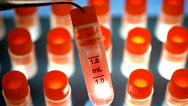
Stem Cells: Early Research
NOVA scienceNOW's first story on stem cells covered the hopes and controversies of stem cell research in 2005.
-
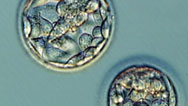
The Politics of Stem Cells
In 2005, the legislative landscape of stem cell research was rocky and bewildering, as Kyla Dunn explains.
-
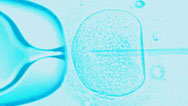
Stem Cells Poll
Should we create human embryonic stem cells through cloning?
-
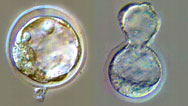
The Cloning Process
Microphotographs show step-by-step how scientists create a cloned mouse embryo to generate embryonic stem cells.



